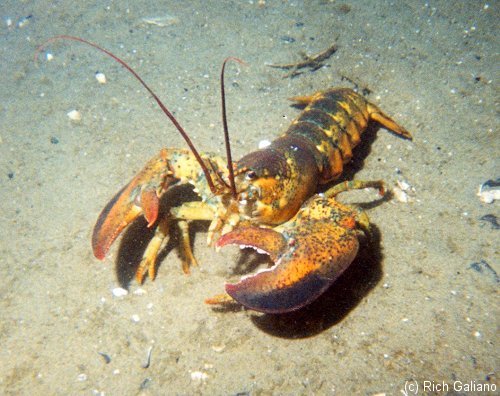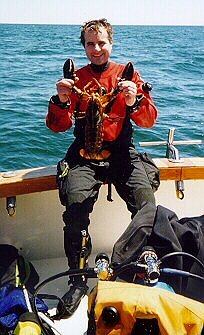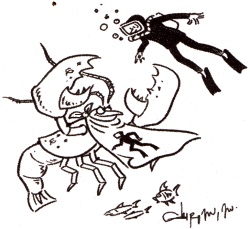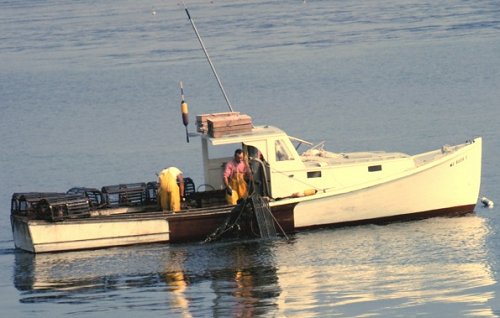Lobstering - The Hunt

The first thing about catching a lobster is don't be too afraid of it. Small lobsters - restaurant-sized 1-2 pounders - are not strong enough to really hurt you. Wear a good heavy pair of gloves, and their pinch may be painful, but not damaging. Larger lobsters deserve more respect, because they certainly can hurt you. Really big ones could even break bones. I had a big one once bite me so hard it gave me nerve damage in my thumb. I boiled him personally, and the numbness and swelling went away after a few weeks.
If you find a lobster out in the open, grab it by the body behind the head from behind. They can't reach all the way back with their claws. For a small lobster, you can also grab both claws and the face all at once from in front. This gives you a secure grip on the whole thing, and he can't pinch you. With bigger lobsters, you may want to subdue the crusher claw first, since of the two that is by far the stronger. In any case, stuff it tail first into your bag, and be careful of the claws - he may still grab at you. The worst hurt I ever got from a lobster came after I had already won the battle! Make sure you close the bag up securely - I have had to catch a number of bugs twice.
Most lobsters are not this easy, and you will have to work for them. Remember, in any confrontation with a bug, you outnumber him - don't forget you have two hands. Generally, you will find your adversary facing you from inside a hole. If it's a small one, ignore the claws and grab it by the body. Speed is essential here. As soon as the lobster senses your attack, it will retreat into its hole. If you grab a claw first, a small lobster will simply shuck it off and get away. A favorite tactic on their part is to wedge the point between their eyes into the ceiling, making them impossible to extract. Push down and twist 90 degrees to either side, and you can pull it right out. If possible, the "both claws and face" grab described above works well.
The best attack is a fast one. Take a few moments to set yourself up. Align your hand, arm, and shoulder with the opening of the hole. This usually means you will not be able to see inside anymore, and so you will be working blind. Grasp something solid with your other hand, and then lunge with all your might. There are three possible outcomes to this strategy:
- You get him, preferably by the big dangerous crusher claw or the tail. You win.
- He gets you. Ouch, but you can still win if you are determined.
- Nobody gets anybody - lobster wins. He is playing for his life, after all.
Big bugs are much less likely to shuck off a claw since they have so much more invested in them. In fact, I'm not sure, but they may not even be able to. If a lobster looks big enough that he might actually hurt you, grab for the crusher claw and pin it shut ( keep in mind that you will probably have to do this all by feel. ) At this point, your adversary will do two things. First, he'll wedge his head into the ceiling, and second, he'll attack you with his other claw. Try to ignore the ripper claw, it's usually not very strong. Extend a finger over the lobster's head, and push back and down if he has successfully wedged himself. Once you've extracted your dinner-to-be, hold both claws in one hand and bag him.
If a big lobster does get a hold of your hand or finger, there are several ways to get him to let go. Relax your grip, or even release it - the bug will probably do the same when it senses its chance to escape. If you are quick, you can grab at it again. An alternative that sometimes works is to shake the lobster as hard as you can, which seems to momentarily discombobulate it. If you have the bug out of his hole, put him in your bag, where he might feel safe and let go. If none of these things works, get a big rock and bash him.
It is often useful to have some sort of a stick or "tickler" when lobstering. Some people use car radio antennas, copper tubing ( which can be coiled-up, ) or purpose-built telescoping ticklers. I prefer a length of 1/2 " ID PVC pipe, with a brass snap at one end. This is stiff enough to use as a pry bar when necessary and is useful for many other things as well. A stick can be used against a lobster in a number of ways. If his hole is too deep for your arm, but you can still reach him with a stick, get him to grab it. Then give a lightning-quick jerk, and before he can let go, you can pull him within range of your other hand. ( They have bad reflexes, remember? ) Alternatively, if there is a back door or other opening to his hole, you can use the stick to drive him out into the open. Finally, with a stiff stick, if you can get it behind him you can just push him out.

Some other ways of coaxing a lobster out of its hole include:
- Catch a smaller lobster and put it in. The surprise will drive the big lobster out.
- Push a bunch of sand into the hole, to raise a big choking cloud of sediment inside. This will eventually drive the lobster out of the hole to breathe.
I don't believe that either of these methods actually works. Sometimes you can draw one out from the back of its hole by shining your light on the sand in front of it. However, if you shine your light right on it, the bug will lose its curiosity and retreat even deeper.
Another way to bring a coy lobster within reach is to bait it. Kill a small fish like a cunner, slash it open, and leave it in the entrance of the critter's hole. Leave the area for a while - at least ten minutes - then sneak back up to the hole ( without your light ! ) and see if the bug has come out within reach. You may just be able to snatch it. Of course, this method requires patience and bottom time, which you may not have. It also depends on no other diver blundering by in the interim and scaring the bug away for good.
Finally, the essential thing to catching lobsters, and something a beginner could not possibly have, is knowing where they are. If you wonder why the boat crew consistently cleans up the lobsters while no one else can, it's not simply because they got in the water first. At most, only one or two crew got in before you did. They get them because they dive a lot, they're familiar with the wrecks and know where the best holes are at each location. This is something you can learn. Make friends, go in with them, ask. You may not get their super-best spots, but most will be happy to help you out.
Finally, I would like to mention that it is very poor form to pull the claws off a lobster as you try to catch it. Although they are capable of regrowing lost limbs, claws represent a huge energy investment to the animal, energy that would be better spent growing bigger than growing new claws if it turns out that for some reason your quarry is not a keeper. My guess is that most lobsters do not survive losing both claws - they are defenseless, and their ability to dig or feed is severely reduced. So be sporting and considerate, and try to catch them intact. When you do catch a lobster that turns out not to be a keeper, don't put it back in its hole. Instead, place it down out in the open, so that the next diver of your party that comes along won't start abusing it all over again. The lobster will eventually find it's way home, but for the moment it will be safer in plain view.
Once the water temperature drops below 50°F, lobsters start to disappear. Most of the males walk off to deep water, while the egg-carrying females dig in to wait out the winter. At these times, almost all of the lobsters you will find will be pregnant females, so it is especially important to be gentle and not harm the animal while capturing it, since you will most likely have to set it free after a quick inspection for eggs. In compensation, lobsters seem to slow down greatly at temperatures below 50°F, so the few that you do find will be easier to catch.
Put your catch in a cold cooler to keep it alive. Meltwater from ice will kill a lobster if it reaches its gills, so drain the cooler regularly or use freezer blocks. Frozen bottled water bottles work very well. Lobsters spoil quickly after death, so cook any dead ones immediately when you get home. Otherwise, they will keep alive in the refrigerator for several days in a dry bowl under a damp towel.
Lobster spoils very quickly after death. A freshly dead lobster may still be cooked and eaten, especially if it was refrigerated, but a dead warm lobster should be discarded. Lobsters may be frozen live and cooked later, but this makes the meat stick to the shell. For long-term storage, it is better to cook the lobsters partially and then freeze the tails and claws. Reheating should be enough to finish the cooking process.




